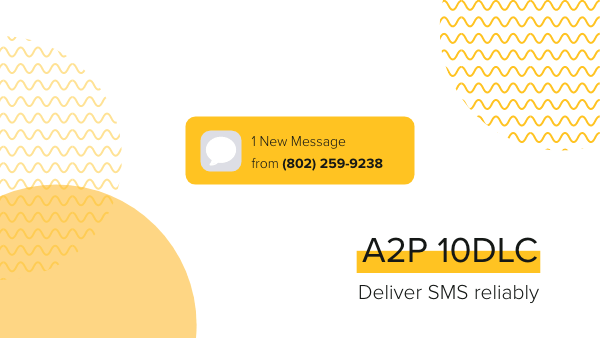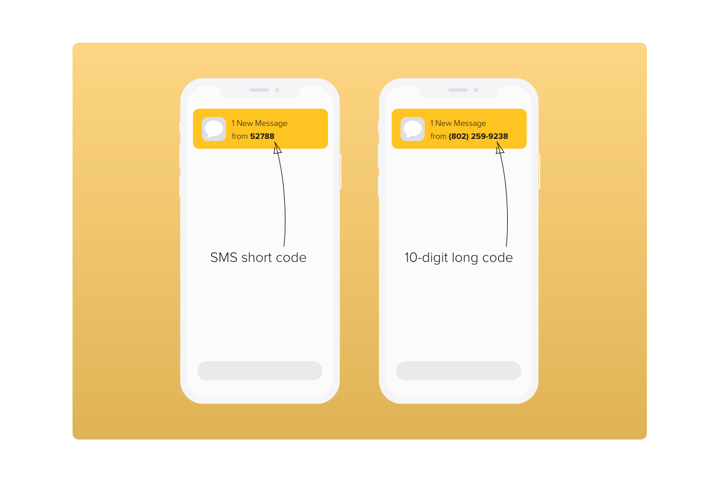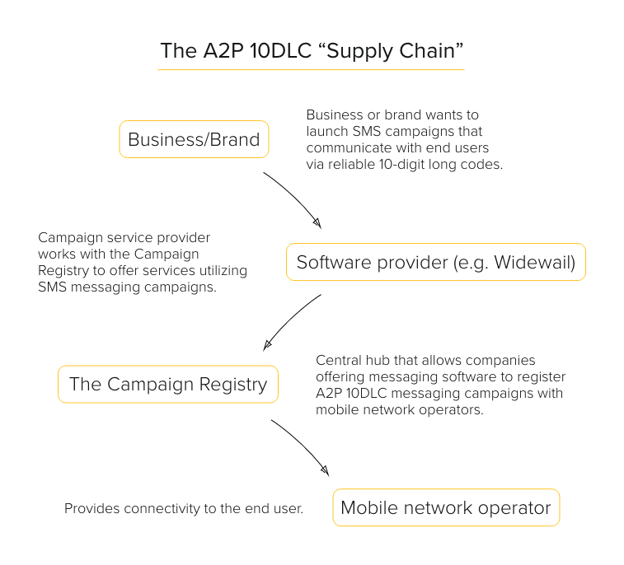-
Products
TechnologyManaged Services
- Resources
- Pricing
- Company
“Application-to-person 10-digit long codes” should turn consumers toward your business, while you spend less.

While the string of letters and numbers might initially turn you away from exploring A2P 10DLC, its functionality is designed to do exactly the opposite: “Application-to-person 10-digit long codes” should turn consumers toward your business, while you spend less.
In short, (Application-to-person) 10DLC (10-digit long code) is a channel for business-to-end-user messaging. It differs from local long codes in that local long codes are P2P (person-to-person) channels. Specifically, with A2P 10DLC, messages are delivered via text (SMS) from local landline numbers to a consumer’s own phone number, making 10DLC perfectly geared for businesses looking to send bulk SMS messages for much less money.
For the consumer, receiving a text through this method is the same experience as receiving a personal communication: they get a notification from a familiar number style, they take a glance, they gain the right information. For your business, the experience should be akin to sending an email to your database of contacts — but with less work, less cost, and higher deliverability.

We all know how important texting is to consumers. It doesn’t really matter what we’re communicating about: short-form reigns supreme. But with every new channel comes a new set of responsibilities for a business to manage.
Consider the Wild West days of email, when spam filters were mostly bunk and businesses weren’t being held accountable for the addresses in their databases. Not only were consumers pestered by irrelevant messages, but CRM providers suffered in deliverability. Perhaps most concerning: brand leaders were spending time and money shooting out messages that would erode, rather than bolster, their brand reputations. Yikes.
Something had to change. Regulations took hold. Today, in most cases, businesses are no longer able to send unsolicited communications through a reputable CRM. In other cases, consumers’ spam filters have to do the work.
Point is, no one wants to repeat the mistakes of channels past. It benefits everyone, carrier to end user, when messages sent via 10DLC are valuable: The mobile carriers who supply these channels are incentivized by profit to support channel traffic, and that means delivering content consumers can trust. After all, a low-lift, high-value channel opportunity awaits!

One of the ways to ensure you’re taking advantage of the opportunity with every campaign is to register all of your SMS campaigns through one of several verified groups. However, because it’s pretty likely that you use other software to manage these campaigns, your effort as a sender becomes more about validating the software/campaign service provider you use, i.e., doing your due diligence.
For instance, if you were thinking about a way to generate more reviews, and you’d landed on SMS (right choice!) you’d want to be sure your review generation software selection is up on the latest registration requirements. Any campaign service provider you select should commit to creating a layer of protection for deliverability and performance through registration.
To protect end-users from data in unsanctioned long codes, mobile network operators AT&T, T-Mobile, and Verizon Wireless work with The Campaign Registry as a third-party registration for companies implementing consumer text messaging campaigns. As an example, Widewail declares messaging and senders (our clients) through The Campaign Registry in order to create a better and more trusted messaging ecosystem for your end customers and to help companies avoid restrictions or penalties on unregistered text campaigns.
Most recently, Widewail has taken this process a step further and created a first-in-class integration of its review generation software with The Campaign Registry.
Our work with The Campaign Registry is a service to our clients —one which no other review generation company provides.
In becoming the first such company to take these steps, Widewail is not only leading in our commitment to industry best practices but also ensuring customers’ registered campaigns are fully supported — a critical factor in capitalizing on 10DLC.
And whether 10DLC is in your current channel plan or not, it should be. (After all, registration is hot because 10DLC is hot.) The other numbers you may have used for SMS and even A2P in the past have their advantages, but none are quite so efficient as 10DLC. Let’s examine some of the other options and find out what they’re missing.
Most businesses and organizations who have already embarked on SMS campaigns will have had a set of decent, though not perfect, options for sending, including short codes (five- or six-digits instead of 10), toll-free long codes, and local long codes. All have pros and cons and can be generally rated for their success based on what your business requires from your SMS campaigns, re: cost, performance, and even risk.
These five- or six-digit numbers can allow for sending up to 500 messages per second in some cases, which is a lot of their appeal. Many companies lease short codes to gain a “permanent” number, so their brand can be associated with that number, allowing for additional consumer trust to develop.
Cost
Leasing an SMS short code for your business isn’t cheap. A monthly cost plus messaging fees could run you well into the thousands per month.
Contracts
You might only need a short code for one campaign but be required to lease for months at a time. Additionally, a longer, more involved approval process (from cell networks) means you invest a lot of time before your campaign can even get started. These contract and approval issues amount to additional risk for your business. You could avoid those risks and achieve nearly the same results with other options.
Speed
The extremely high throughput of short codes means you can always reach a lot of eyes at once — probably their most well-known selling point.
Perception
That same selling point — serious bulk and serious speed — can lead to campaigns that pull consumers away from the positive experiences they have elsewhere with a brand. A short-code number can sometimes indicate to consumers that they’re simply part of your campaign database. It might also cause confusion for consumers who want to initiate a conversation with your brand. Finally, the very fact that these codes aren’t typical ten-digit codes can set off some consumers’ personal spam radar, as well, leading to a negative brand perception or lack of trust.
Typically a voice-only number that can be text-enabled, toll-free long codes are used by businesses to support A2P messages such as customer service announcements. Toll-free long codes are highly reliable but may be less trusted by skeptical consumers than a 10DLC message.
Cost
Where short codes are expensive, toll-free long codes are, well, toll-free. They also require less initial time investment for approval than short codes — minutes compared to weeks. But, depending on how many messages you’ll send and at what frequency, they’re less cost-effective overall due to throughput.
Speed
Toll-free long codes generally offer higher throughput than P2P long codes (naturally), but lesser throughput than short codes. Consequently, they’re less cost-effective for bulk messaging than short codes are, and present some limitations on the timing of messages, including review requests. Because timing is a major factor in personalization, the lack of flexibility here can affect consumer perception.
Perception
Local reigns. Toll-free numbers can look like they’re coming from anywhere, which can appear impersonal to anyone receiving your bulk message, thereby discouraging the consumer from engaging with your campaign. If the point of SMS is to personalize while minimizing effort, a toll-free long code is not the best option.
A local long code is really just a standard phone number designed for P2P (person-to-person) rather than A2P messaging. For this reason, they’re much less likely to be used by your business to achieve campaign objectives. But the many benefits of these standard numbers show us why the evolution to an A2P version is so necessary.
Cost
Local long codes are super affordable. Given that P2P messaging is an individualized effort, they aren’t able to be used for bulk messaging the same way short codes are — making them less cost-effective.
Reliability
While you could, in theory, use local long codes to individually message your customers, using them for commercial purposes is technically a compliance issue. They’re designed for P2P, and therefore will always present limitations.
Contracts
Set up/approval is minimal, letting you get right down to business with a long code.
Perception
Consumers are likely to enjoy an SMS message received via a long code. It gives them a single point of phone contact for your business, and messages appear more personalized, supporting brand integrity via customer experience. Long codes can also be used for two-way conversations, and every message is specifically tailored. Again, standard local long codes have been used for P2P in the past; A2P long code messaging may not have all the same brand effects as actual person-to-person messages.
But it will, at the very least, have the commercial capacity that local long codes have lacked.
As you can see, none of the previous options available to businesses really hit the mark on low-cost, fully-compliant, trustworthy SMS messaging.
Enter 10DLC.
10DLC addresses the need for sending multiple messages to commercial audiences quickly, via the same local number. While there are dozens of recommended uses for this emerging channel, how you leverage 10DLC will come down to your business goals.
Are you trying to initiate two-way conversations? Deliver appointment reminders? Maybe you’re trying to create brand buzz and remain top of mind. Or maybe you’re trying to generate more, higher-quality reviews.
For the last one, Widewail’s Invite and Invite Video can help. And now that it’s integrated with The Campaign Registry for A2P 10DLC, your due diligence for registration is built right into your next review campaign. With Invite utilizing 10DLC, your customers see your messages coming from trustworthy phone numbers and by being pre-approved by mobile network operators, deliverability is maximized.
I’m the Director of Marketing here at Widewail, as well as a husband and new dad outside the office. I'm in Vermont by way of Boston, where I grew the CarGurus YouTube channel from 0 to 100k subscribers. I love the outdoors and hate to be hot, so I’m doing just fine in the arctic Vermont we call home. Fun fact: I met my wife on the shuttle bus at Baltimore airport. Thanks for reading Widewail’s content!
Bite-sized, to-the-point, trend-driven local marketing stories and tactics.
Automated Review Generation
Video Testimonial Generation

Maintain Accurate Listings

Private Surveys
Review Response Managed Services
Social Media Engagement Services
©Widewail 2025.
U3GM Blog Post Comments